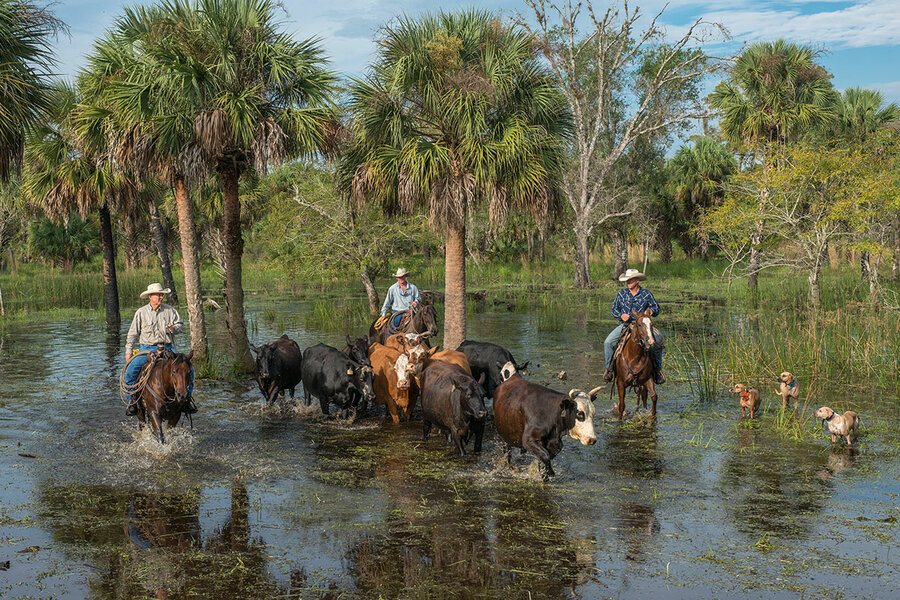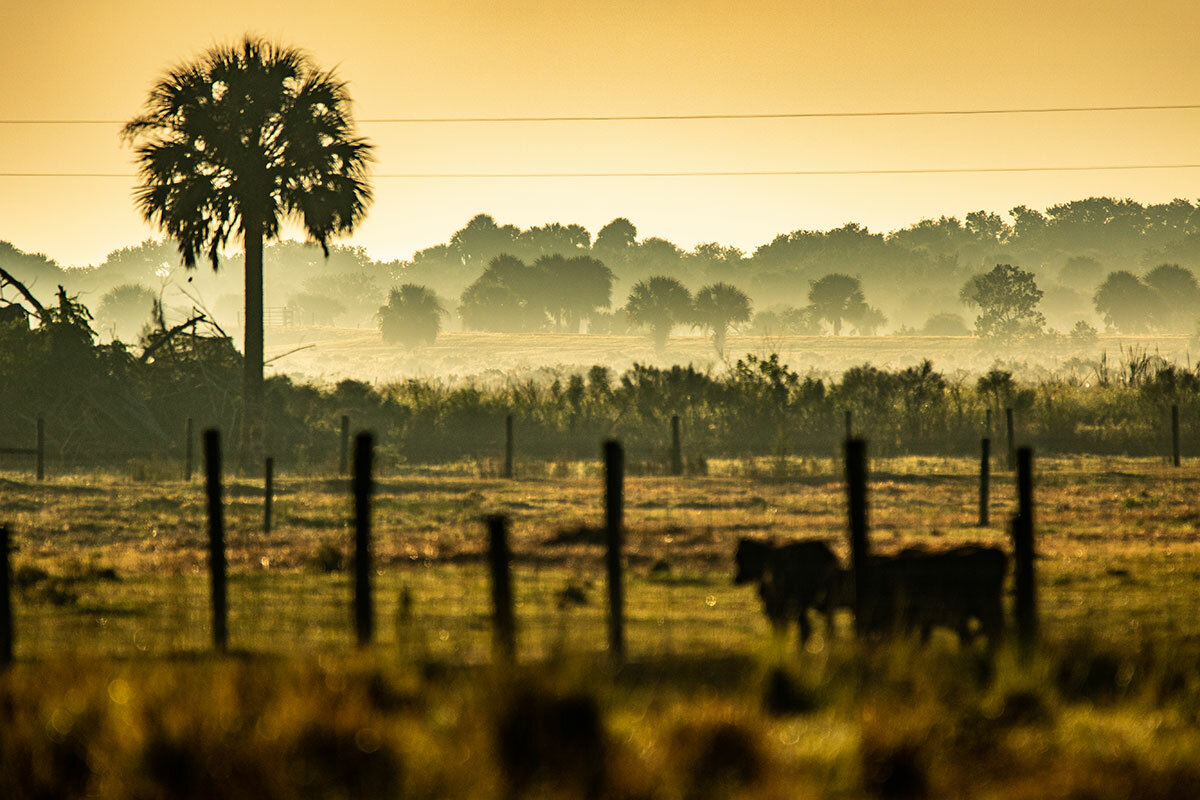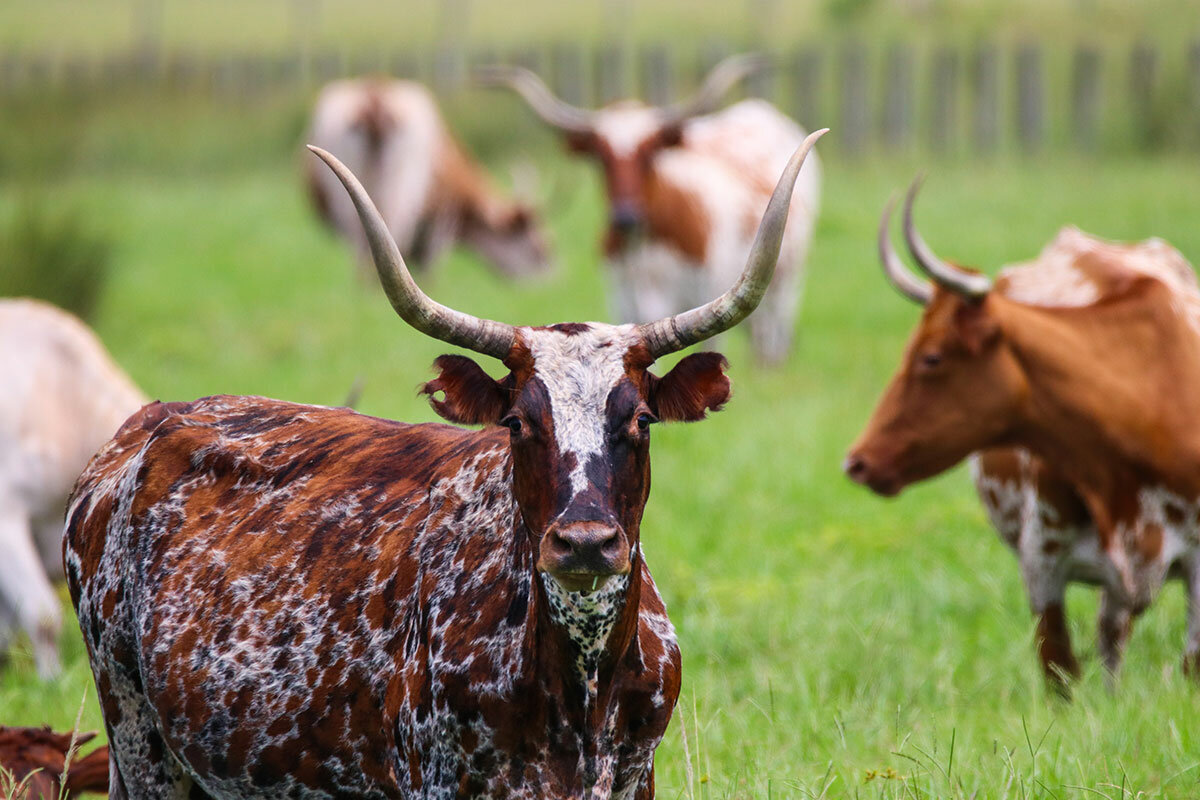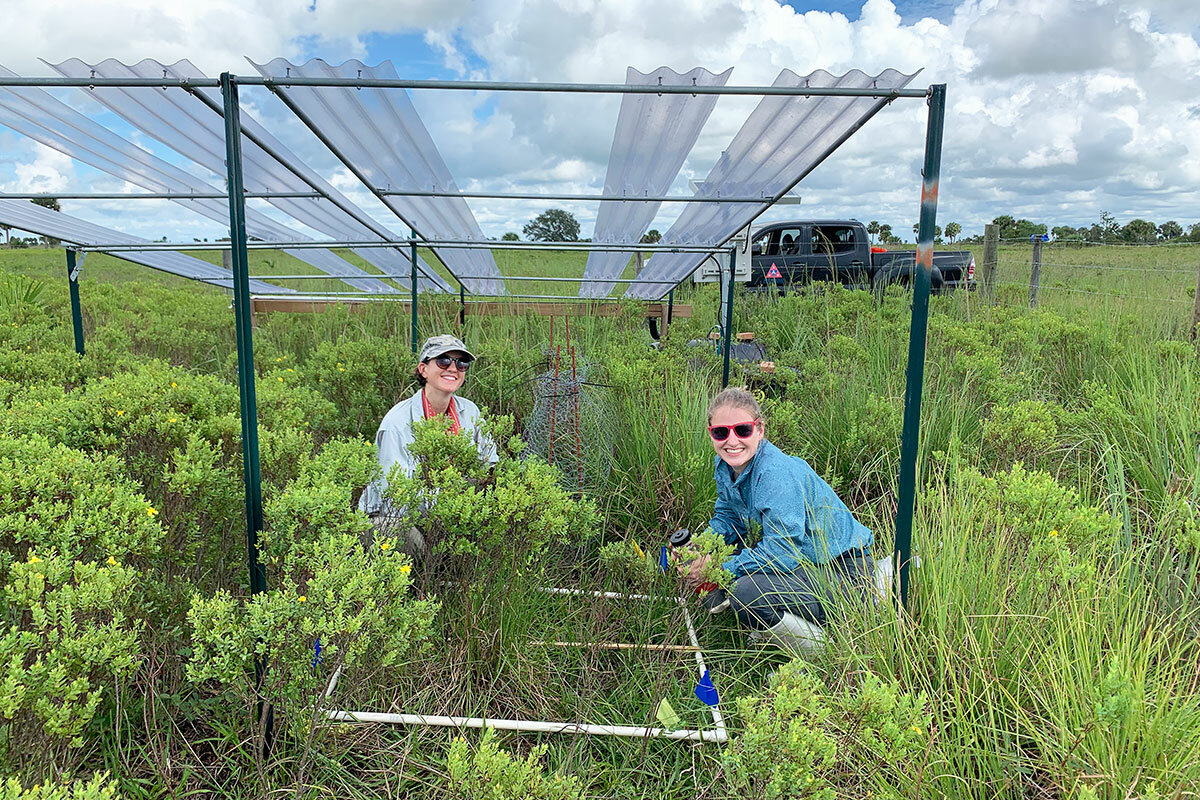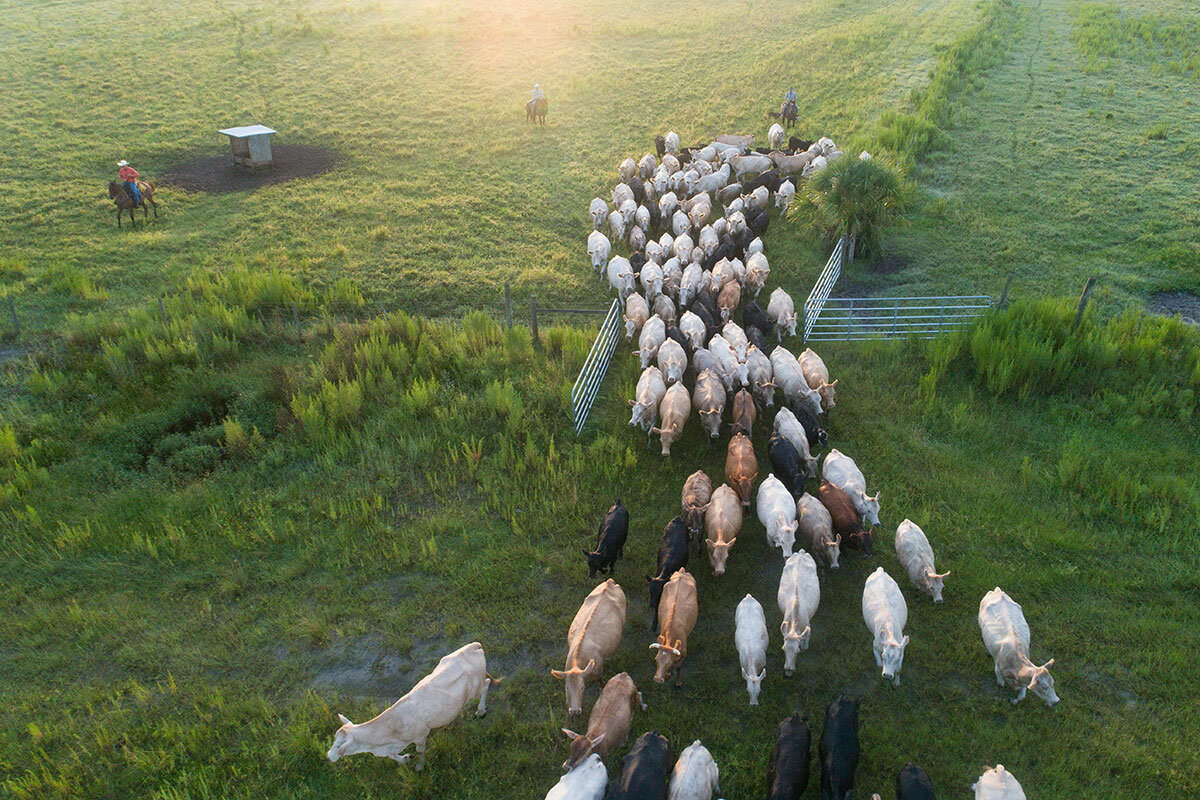Rescuing ‘wild Florida’ – by saving cattle ranches
Loading...
| Gainesville, Fla.
Some days Wes Carlton wants to turn off his phone. The calls from developers wanting to buy pieces of his four large cattle ranches in central and south Florida roll in almost constantly.
“Imagine you have something your grandmother gave you,” he says, “something precious and dear to your heart, and people are calling you all the time asking, ‘Can I buy it? Can I buy it?’ It’s like, ‘Quit calling me.’”
A fourth-generation cattle rancher, Mr. Carlton is a firm advocate for the Florida beef industry. He and his family have won awards for good environmental stewardship of their land. He has no plans to sell it off. But he understands the pressure that virtually all Florida ranchers are under from developers and why many ranchers choose to sell.
Why We Wrote This
A story focused onRanches are some of the last strongholds for nature and scientific discovery in the Sunshine State – but they’re disappearing fast at the hands of developers.
Land values have been rising for decades as more and more people move to the state. In 1960, Florida was home to fewer than 5 million residents. In 2022, Florida’s population was 22 million – and growing fast. More people in the United States moved to Florida than to any other state in 2022. Demographers liken the growth to adding a city about the size of Orlando every year.
Florida’s wild landscapes are vanishing as developments spring up to accommodate these new residents. Vast expanses of prairie, forest, and wetlands have now been converted to large-scale housing developments or entirely new planned cities and towns. And ranchlands, which encompass large swaths of these natural habitats in the north and central part of the state, are being swallowed up as well.
But these lands are necessary to the state’s future viability, providing benefits that lawmakers now realize can’t be ignored: Ranchlands produce food and clean water for Floridians; they offer critical habitats for wildlife; they even serve as buffer zones for military bases. And they are necessary for the restoration of the Everglades, a project expected to cost more than $23 billion in government funds and upon which much of Florida’s future water supply depends.
In June, Florida Gov. Ron DeSantis approved one of the Legislature’s largest-ever investments in land conservation. Nearly $1 billion has been earmarked to protect Florida’s natural and agricultural lands from development, including ranches, timberlands, and croplands. And in 2021, in a rare unanimous vote, Florida lawmakers passed the Florida Wildlife Corridor Act, which set aside $400 million to preserve nearly 18 million acres of wildlife habitat, 7 million of which are working ranchlands and timberlands.
Julie Morris, a wildlife ecologist and director of the Florida Conservation Group, says she is “cautiously optimistic” that funding for land conservation will continue in the coming years. But she worries that in the race against development, conservation efforts will continue to lose ground.
“We have a very time-limited opportunity to protect these lands,” she says. “And the development pressure is very, very intense.”
“Myth-busters” on a cattle ranch
In Florida’s Kissimmee River Valley, where the headwaters of the Everglades begin their southward flow, a 10,500-acre working cattle ranch also serves as a living laboratory for scientists. The partnership between Buck Island Ranch and the Archbold Biological Station (which owns the ranch) represents a unique collaboration between ranchers and scientists, one that has yielded surprising discoveries about the environmental benefits of ranchlands.
“We are kind of like myth-busters,” says Elizabeth Boughton, senior research biologist and program director of agroecology at Archbold, a nonprofit that studies the ecology of working lands. “People have this preconceived notion that cows are bad, ranching is bad, agriculture is bad, but we’re looking at ways where we can minimize the tradeoffs and understand the benefits of ranching to nature, water, and carbon.”
Dr. Boughton and her colleagues have experimented with ranching practices that benefit both the cattle operation and the environment. For one research project, they tested growing and harvesting forage for cattle as a way of removing from pasture soils the nutrient pollution derived from past fertilizer use. Growing their own hay reduces ranchers’ reliance on imported feed and helps prevent excess nutrients from entering the watershed, where they feed the state’s smelly, toxic algae blooms.
The natural wetlands and flood plains comprised in ranchlands help capture and filter water as it moves through the landscape, which means better flood protection for urban communities and improved water quality – including drinking water from aquifers. The native vegetation does such a good job of filtering water and absorbing toxic fertilizer runoff, that regional water management authorities have experimented with programs that essentially pay ranchers to maintain their wetlands.
Much of Florida’s native wildlife also depends on ranchlands for survival. Florida ranches allow space for large mammals like the endangered Florida panther and the Florida black bear to roam. And they provide habitats for many other species, from wading birds and bobcats, to wild turkeys and otters. For some at-risk species that have lost most of their native Florida habitat to development, like the burrowing owl and the Florida grasshopper sparrow, ranches represent some of the last scraps of habitat for them.
How the state protects ranchlands
The threat to Florida’s rich biodiversity has helped scientists target high-risk areas for conservation – and helped lawmakers justify spending on it.
“Florida is number one in the nation for science-based land conservation,” says Ms. Morris, the wildlife ecologist. “We know where our important areas are.”
That includes privately owned lands. Without the cooperation of landowners, conservation efforts will not keep up with the pace of development in Florida, she says.
In recent years, conservation easements have emerged as the primary mechanism for protecting private lands from development in Florida. Conservation easements mean the government buys the rights to develop land from the landowner, but the landowner retains ownership. Landowners can continue to raise cattle or timber or crops, but they can’t turn the land into houses or roads, or sell to a developer who would. (Florida is unusual in that the largest easement holder in the state is its own government. In most other states, the largest easement holders tend to be the federal government or nonprofits like The Nature Conservancy.)
Conservation easements will become a lifeline for Florida agriculture in the years to come, predicts Tom Hoctor, director of the Center for Landscape Conservation Planning at the University of Florida. “I suspect there will be a day in Florida,” he says, “when all agricultural lands or the vast majority of agricultural lands, if they still exist, will be protected by some form of easement.”
The alternative, he says, is “to have most ranches disappear over the next 50 or so years because of development.”
Tough choice for ranchers
Florida’s ranching history stretches back 500 years, to when Spanish colonists first introduced cattle to America. Travel into the heart of Florida ranchlands, and the landscape still looks much as it did then. Ancient cypress swamps, moss-draped oak hammocks, sunbaked prairies, and freshwater marshes where tall grasses rustle in the wind and alligators glide through narrow waterways: These scenes still form the backdrop of ranching in Florida, and they are beloved by many ranchers.
“Ranchers, in my mind, are the original conservationists,” says Gene Lollis, manager of Buck Island Ranch. Mr. Lollis says that most ranchers feel a responsibility toward their land and the diverse ecosystems and wildlife it supports. They are also proud of, and want to protect, their role in domestic food production.
But ranching is not an easy business. Profits are chipped away by the costs associated with animal care, land management, and taxes. Beef prices fluctuate. Recovery from hurricanes and extreme weather eats up even more income. And in some cases, the younger generations of old ranching families are not willing to stay in the business.
Meanwhile, developers are knocking at the door.
“The ranchers that I work with love what they do, but it is a very, very slim profit margin,” says Ms. Morris. “And often what happens, you know, you have a kid who needs to go to college or somebody gets sick. ... People are forced to sell off bits and pieces [of their land], to cover expenses.”
Conservation easements can provide a much-needed source of income for ranching families, as well as some security for the future, she says.
But will that easement money carry landowners through lean times? Entering into a conservation easement is a decision that ranchers must make not only for themselves, but also for their children, grandchildren, and so on – unless they or their heirs decide to sell the land, at which point it will be worth less than if it were not under easement.
Florida’s two state-funded conservation easements programs, Florida Forever and the Rural and Family Lands Protection Program, typically offer landowners 40 to 55 cents on the dollar of their property value, which is determined by an appraiser and based on the land’s development potential. Under state law, the government can’t offer more.
But developers can, and do.
“When it comes to conservation, it really depends on an individual and their willingness to perhaps take less than the actual value of a said piece of land,” says Mr. Lollis.
Ranchers can wait years for funds
Despite increasingly attractive offers, more ranchers are seeking to put their land out of developers’ reach. Both state conservation easement programs have seen an influx of applications from landowners in recent years.
Asked if there is enough funding to buy the development rights of every landowner looking to sell them, however, Ms. Morris says, “Absolutely not.”
“I think we could get a billion dollars next year for Rural and Family Lands and Florida Forever and spend it,” she says. “And that’s not a number I’m throwing out. That’s a number based just on lands that are on the [application] list.”
True, the state’s new budget does set aside nearly $1 billion for land conservation. But most of that is for land acquisition, though $100 million is going to Florida Forever, which also handles easements. Conservationists were disappointed that Governor DeSantis vetoed another $100 million for agricultural easements via the Rural and Family Lands Protection Program. (The governor’s office maintains there are unspent funds that can still be used.)
Currently, more than 1 million acres of private land sit on the application lists for Florida Forever and the Rural and Family Lands Protection Program. And while those landowners wait – for years, in some cases – for their applications to get approved, more and more green space is vanishing beneath new subdivisions, apartment complexes, strip malls, big-box stores, and roads.
The University of Florida’s Center for Landscape Conservation Planning projects the loss of more than 150,000 acres of ranchland by 2030, under what it calls a “business as usual” scenario. Taken together, that’s a swath of land about twice the size of the city of Orlando. And that does not include other types of agricultural lands, or natural lands.
“We need consistent, robust funding for a dedicated number of years to get these lands protected,” says Ms. Morris. With steady funding, she adds, “There is an opportunity for us to save what’s so precious and unique in this state.”




